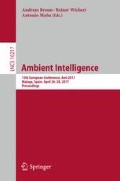Abstract
This keynote presentation explores the role of Ambient Intelligence in current technical and social contexts related to smart cities. Having identified some undesirable tendencies, conclusions and design recommendations are provided on how to remedy the situation. This includes the need for redefining the ‘smart everything’ paradigm, in order to reconcile humans and technology.
It starts out with placing Ambient Intelligence in the context of Ubiquitous Computing, Disappearing Computer and Internet of Things (IoT). The application areas discussed are motivated by living in the Urban Age, i.e. the increasing importance and preeminent role of cities. Examples are ‘transient spaces’ and airports viewed as ‘transient cities’. Different notions of the ‘smart city of the future’ are introduced and complemented by the concept of ‘hybrid cities’, i.e. integrating the virtual, digital world with the real, physical world.
The current hype about abundant business opportunities of smart cities requires a critical investigation. The Internet of Things (IoT) provides the infrastructure for collecting data about urban objects and citizens including their behavior. A wide range of information is combined and subjected to extensive ‘big data’ exploitation efforts – very often conducted without explicit consent of the people involved. In order to explore the challenges, but also the venues towards a more human-centered IoT, resp. an Ambient Intelligence approach, one has to explore the implications of matching people’s profiles with service options available at specific locations. A major focus is on the risks resulting from smart city installations, especially the serious infringements of privacy rights, i.e., usage of personal data without consent of the people concerned.
Our thesis is that a critical reflection of different manifestations of the ‘smart everything’ paradigm is needed in order to meet the overall goal of reconciling humans and technology. A central aspect of this goal is to keep the ‘human in the loop’ and in control. Therefore, a citizen-centered design approach for future cities is needed, helping us to go ‘beyond smart-only cities’ and transform them into Humane, Sociable and Cooperative Smart Hybrid Cities.
Access this chapter
Tax calculation will be finalised at checkout
Purchases are for personal use only
Notes
- 1.
For a description of the history of AmI see Aarts and Encarnaçao (2006).
References
Aarts, E., Encarnaçao, J. (eds.): True Visions: The Emergence of Ambient Intelligence. Springer, Heidelberg (2006)
Disappearing Computer (2000–2005). http://www.smart-future.net/themes-and-issues/disappearing-computer/. Accessed 28 Feb 2017
ISTAG. Scenarios for Ambient Intelligence in 2010. Final report. February 2001. European Commission, Luxembourg (2001). http://cordis.europa.eu/pub/ist/docs/istagscenarios2010.pdf. Accessed 28 Feb 2017
Konomi, S., Shoji, K., Ohno, W.: Rapid development of civic computing services: opportunities and challenges. In: Streitz, N., Stephanidis, C. (eds.) DAPI 2013. LNCS, vol. 8028, pp. 309–315. Springer, Heidelberg (2013). doi:10.1007/978-3-642-39351-8_34
Russell, D., Streitz, N., Winograd, T.: Building disappearing computers. Commun. ACM 48(3), 42–48 (2005)
SESAMI. Mission statement by A. Savidis and N. Streitz, the chairs of the ERCIM-Working Group SESAMI (2007). http://www.ics.forth.gr/sesami/index.html. Accessed 28 Feb 2017
Streitz, N.: Augmented reality and the disappearing computer. In: Smith, M., Salvendy, G., Harris, D., Koubek, R. (eds.) Cognitive Engineering, Intelligent Agents and Virtual Reality, pp. 738–742. Lawrence Erlbaum, Mahwah (2001)
Streitz, N.: The disappearing computer. In: Erickson, T., McDonald, D.W. (eds.) HCI Remixed: Reflections on Works That Have Influenced the HCI Community, pp. 55–60. MIT Press, Cambridge (2008)
Streitz, N.: Citizen-centered design for humane and sociable hybrid cities. In: Theona, I., Charitos, D. (eds.) Hybrid City 2015 - Data to the People, pp. 17–20. University of Athens, Greece (2015)
Streitz, N.: Smart cities need privacy by design for being humane. In: Pop, S., Toft, T., Calvillo, N., Wright, M. (eds.) What Urban Media Art Can Do - Why When Where and How, pp. 268–274. Verlag avedition, Stuttgart (2016)
Streitz, N.A., Geißler, J., Holmer, T.: Roomware for cooperative buildings: integrated design of architectural spaces and information spaces. In: Streitz, N.A., Konomi, S., Burkhardt, H.-J. (eds.) CoBuild 1998. LNCS, vol. 1370, pp. 4–21. Springer, Heidelberg (1998). doi:10.1007/3-540-69706-3_3
Streitz, N., Geißler, J., Holmer, T., Konomi, S., Müller-Tomfelde, C., Reischl, W., Rexroth, P., Seitz, P., Steinmetz, R.: i-LAND: an interactive landscape for creativity and innovation. In: Proceedings of ACM CHI 1999 Conference, pp. 120–127 (1999)
Streitz, N., Kameas, A., Mavrommati, I. (eds.): The Disappearing Computer. LNCS, vol. 4500. Springer, Heidelberg (2007). doi:10.1007/978-3-540-72727-9
Streitz, N., Nixon, P.: The disappearing computer. Commun. ACM 48(3), 33–35 (2005). Guest Editors’ Introduction to Special Issue
Streitz, N., Privat, G.: Ambient intelligence. Final section “Looking to the Future”. In: Stephanidis, C. (ed.) The Universal Access Handbook, pp. 60.1–60.17. CRC Press, Boca Raton (2009)
Streitz, N., Röcker, C., Prante, T., van Alphen, D., Stenzel, R., Magerkurth, C.: Designing smart artifacts for smart environments. IEEE Comput. 38(3), 41–49 (2005)
Streitz, N., Wichert, R.: Towards the Humane City: White Paper on a Future Research Agenda. Final report (2009). InterLink website http://interlink.ics.forth.gr/central.aspx?sId=84I241I747I323I344337. Accessed 28 Feb 2017
Weiser, M.: The Computer for the 21st Century, pp. 66–75. Scientific American (1991)
Author information
Authors and Affiliations
Corresponding author
Editor information
Editors and Affiliations
Rights and permissions
Copyright information
© 2017 Springer International Publishing AG
About this paper
Cite this paper
Streitz, N. (2017). Reconciling Humans and Technology: The Role of Ambient Intelligence. In: Braun, A., Wichert, R., Maña, A. (eds) Ambient Intelligence. AmI 2017. Lecture Notes in Computer Science(), vol 10217. Springer, Cham. https://doi.org/10.1007/978-3-319-56997-0_1
Download citation
DOI: https://doi.org/10.1007/978-3-319-56997-0_1
Published:
Publisher Name: Springer, Cham
Print ISBN: 978-3-319-56996-3
Online ISBN: 978-3-319-56997-0
eBook Packages: Computer ScienceComputer Science (R0)


